tires JEEP COMPASS 2012 1.G User Guide
[x] Cancel search | Manufacturer: JEEP, Model Year: 2012, Model line: COMPASS, Model: JEEP COMPASS 2012 1.GPages: 108, PDF Size: 4.03 MB
Page 65 of 108
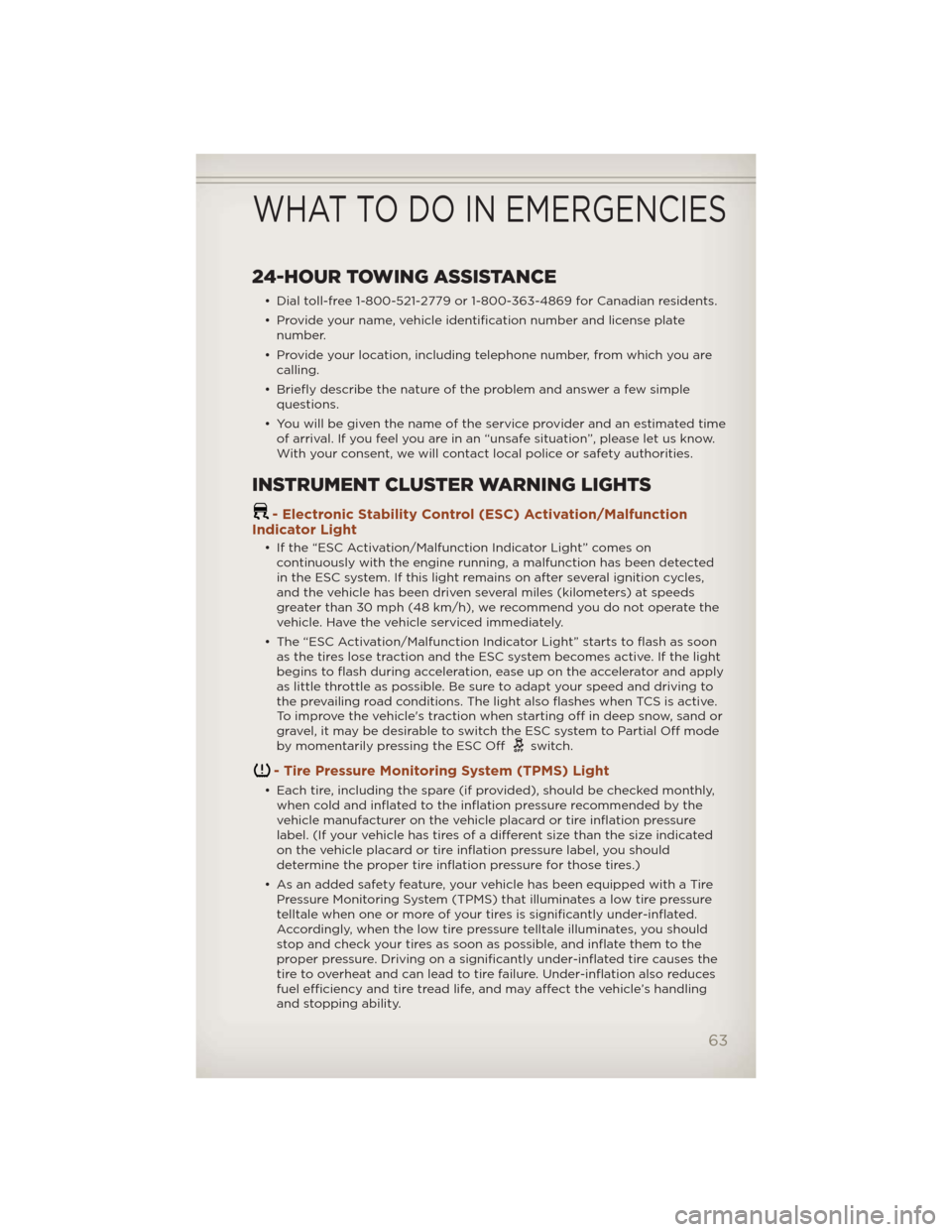
24-HOUR TOWING ASSISTANCE
• Dial toll-free 1-800-521-2779 or 1-800-363-4869 for Canadian residents.
• Provide your name, vehicle identification number and license plate
number.
• Provide your location, including telephone number, from which you are
calling.
• Briefly describe the nature of the problem and answer a few simple
questions.
• You will be given the name of the service provider and an estimated time
of arrival. If you feel you are in an “unsafe situation”, please let us know.
With your consent, we will contact local police or safety authorities.
INSTRUMENT CLUSTER WARNING LIGHTS
- Electronic Stability Control (ESC) Activation/Malfunction
Indicator Light
• If the “ESC Activation/Malfunction Indicator Light” comes on
continuously with the engine running, a malfunction has been detected
in the ESC system. If this light remains on after several ignition cycles,
and the vehicle has been driven several miles (kilometers) at speeds
greater than 30 mph (48 km/h), we recommend you do not operate the
vehicle. Have the vehicle serviced immediately.
• The “ESC Activation/Malfunction Indicator Light” starts to flash as soon
as the tires lose traction and the ESC system becomes active. If the light
begins to flash during acceleration, ease up on the accelerator and apply
as little throttle as possible. Be sure to adapt your speed and driving to
the prevailing road conditions. The light also flashes when TCS is active.
To improve the vehicle's traction when starting off in deep snow, sand or
gravel, it may be desirable to switch the ESC system to Partial Off mode
by momentarily pressing the ESC Off
switch.
- Tire Pressure Monitoring System (TPMS) Light
• Each tire, including the spare (if provided), should be checked monthly,
when cold and inflated to the inflation pressure recommended by the
vehicle manufacturer on the vehicle placard or tire inflation pressure
label. (If your vehicle has tires of a different size than the size indicated
on the vehicle placard or tire inflation pressure label, you should
determine the proper tire inflation pressure for those tires.)
• As an added safety feature, your vehicle has been equipped with a Tire
Pressure Monitoring System (TPMS) that illuminates a low tire pressure
telltale when one or more of your tires is significantly under-inflated.
Accordingly, when the low tire pressure telltale illuminates, you should
stop and check your tires as soon as possible, and inflate them to the
proper pressure. Driving on a significantly under-inflated tire causes the
tire to overheat and can lead to tire failure. Under-inflation also reduces
fuel efficiency and tire tread life, and may affect the vehicle’s handling
and stopping ability.
WHAT TO DO IN EMERGENCIES
63
Page 66 of 108
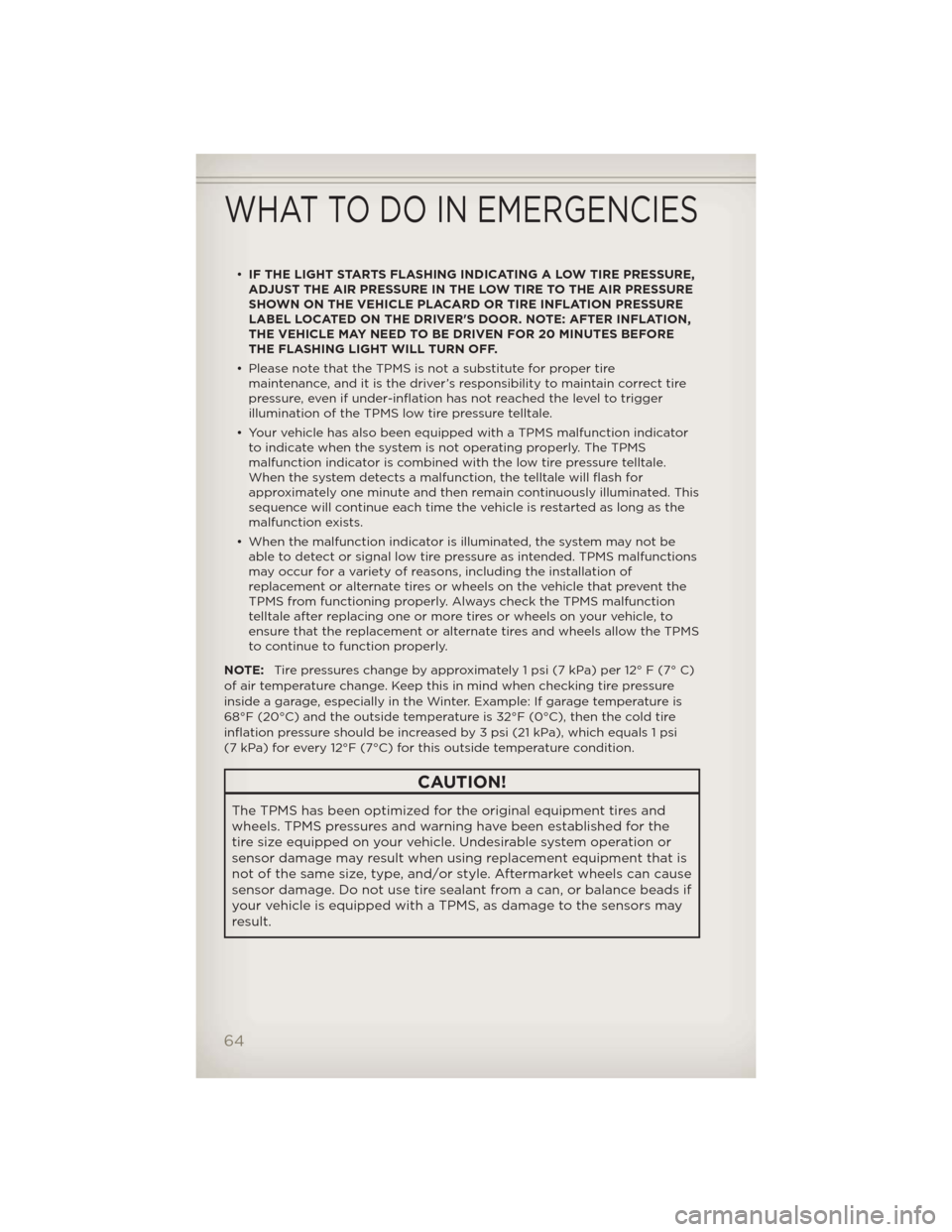
•IF THE LIGHT STARTS FLASHING INDICATING A LOW TIRE PRESSURE,
ADJUST THE AIR PRESSURE IN THE LOW TIRE TO THE AIR PRESSURE
SHOWN ON THE VEHICLE PLACARD OR TIRE INFLATION PRESSURE
LABEL LOCATED ON THE DRIVER'S DOOR. NOTE: AFTER INFLATION,
THE VEHICLE MAY NEED TO BE DRIVEN FOR 20 MINUTES BEFORE
THE FLASHING LIGHT WILL TURN OFF.
• Please note that the TPMS is not a substitute for proper tire
maintenance, and it is the driver’s responsibility to maintain correct tire
pressure, even if under-inflation has not reached the level to trigger
illumination of the TPMS low tire pressure telltale.
• Your vehicle has also been equipped with a TPMS malfunction indicator
to indicate when the system is not operating properly. The TPMS
malfunction indicator is combined with the low tire pressure telltale.
When the system detects a malfunction, the telltale will flash for
approximately one minute and then remain continuously illuminated. This
sequence will continue each time the vehicle is restarted as long as the
malfunction exists.
• When the malfunction indicator is illuminated, the system may not be
able to detect or signal low tire pressure as intended. TPMS malfunctions
may occur for a variety of reasons, including the installation of
replacement or alternate tires or wheels on the vehicle that prevent the
TPMS from functioning properly. Always check the TPMS malfunction
telltale after replacing one or more tires or wheels on your vehicle, to
ensure that the replacement or alternate tires and wheels allow the TPMS
to continue to function properly.
NOTE:Tire pressures change by approximately 1 psi (7 kPa) per 12° F (7° C)
of air temperature change. Keep this in mind when checking tire pressure
inside a garage, especially in the Winter. Example: If garage temperature is
68°F (20°C) and the outside temperature is 32°F (0°C), then the cold tire
inflation pressure should be increased by 3 psi (21 kPa), which equals 1 psi
(7 kPa) for every 12°F (7°C) for this outside temperature condition.
CAUTION!
The TPMS has been optimized for the original equipment tires and
wheels. TPMS pressures and warning have been established for the
tire size equipped on your vehicle. Undesirable system operation or
sensor damage may result when using replacement equipment that is
not of the same size, type, and/or style. Aftermarket wheels can cause
sensor damage. Do not use tire sealant from a can, or balance beads if
your vehicle is equipped with a TPMS, as damage to the sensors may
result.
WHAT TO DO IN EMERGENCIES
64
Page 71 of 108
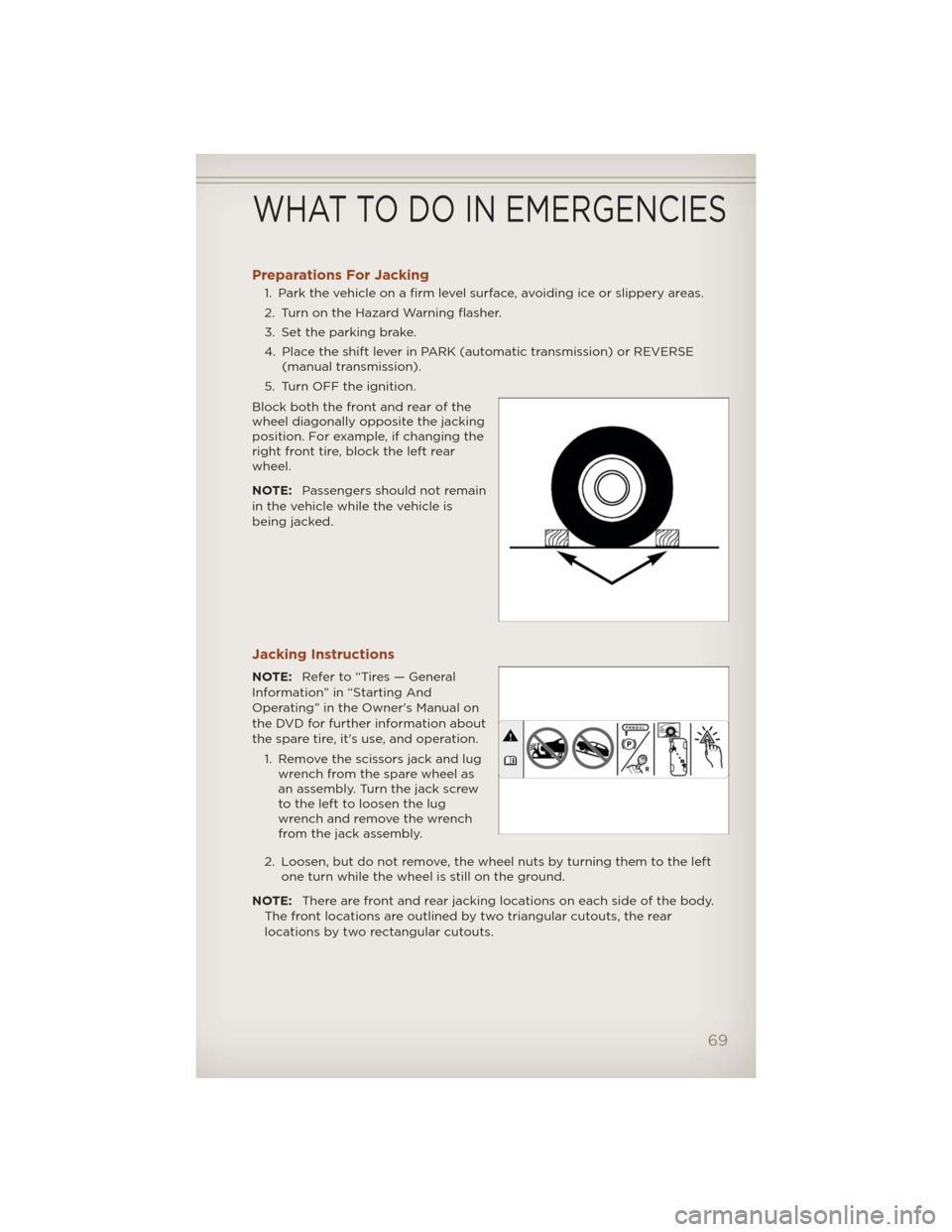
Preparations For Jacking
1. Park the vehicle on a firm level surface, avoiding ice or slippery areas.
2. Turn on the Hazard Warning flasher.
3. Set the parking brake.
4. Place the shift lever in PARK (automatic transmission) or REVERSE
(manual transmission).
5. Turn OFF the ignition.
Block both the front and rear of the
wheel diagonally opposite the jacking
position. For example, if changing the
right front tire, block the left rear
wheel.
NOTE:Passengers should not remain
in the vehicle while the vehicle is
being jacked.
Jacking Instructions
NOTE:Refer to “Tires — General
Information” in “Starting And
Operating” in the Owner's Manual on
the DVD for further information about
the spare tire, it's use, and operation.
1. Remove the scissors jack and lug
wrench from the spare wheel as
an assembly. Turn the jack screw
to the left to loosen the lug
wrench and remove the wrench
from the jack assembly.
2. Loosen, but do not remove, the wheel nuts by turning them to the left
one turn while the wheel is still on the ground.
NOTE:There are front and rear jacking locations on each side of the body.
The front locations are outlined by two triangular cutouts, the rear
locations by two rectangular cutouts.
WHAT TO DO IN EMERGENCIES
69
Page 75 of 108
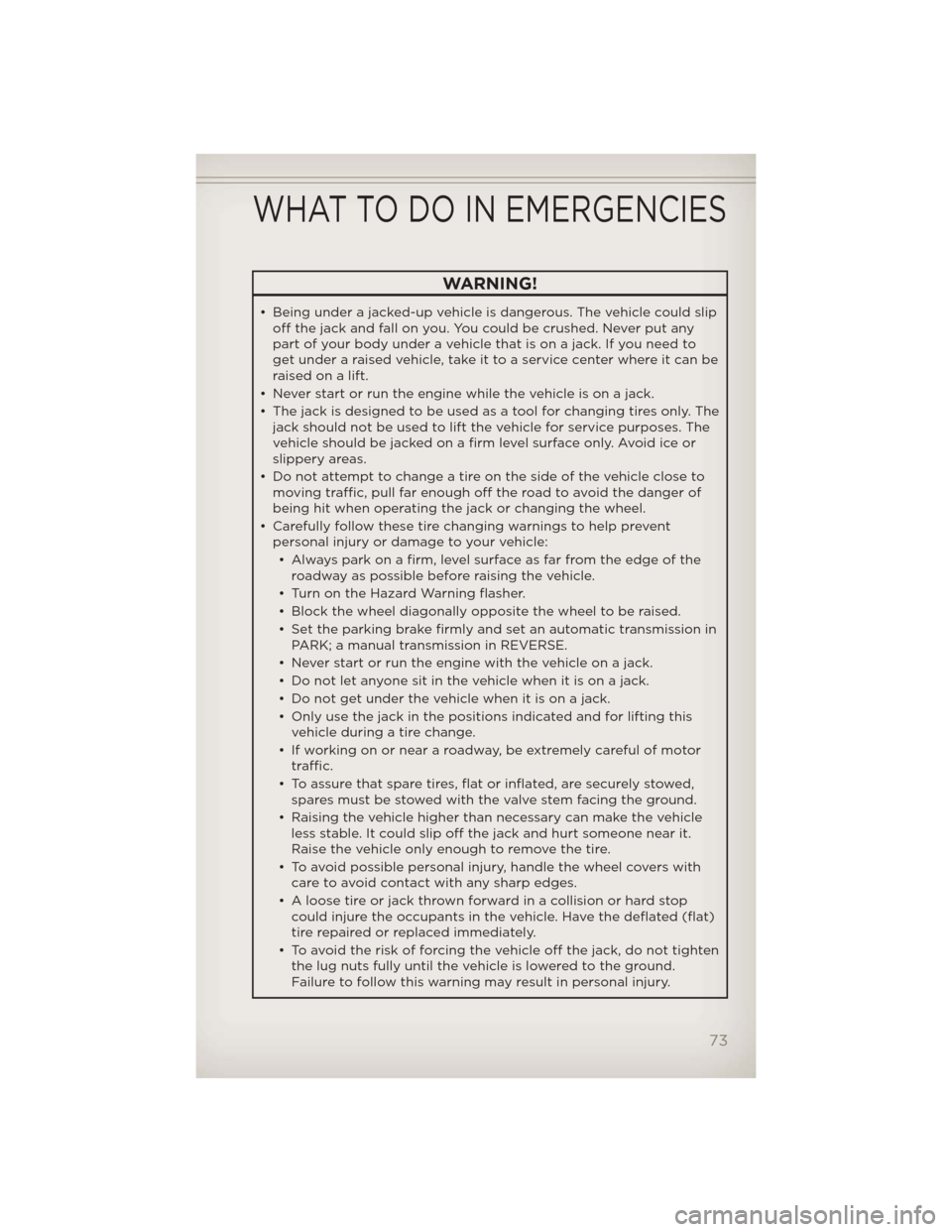
WARNING!
• Being under a jacked-up vehicle is dangerous. The vehicle could slip
off the jack and fall on you. You could be crushed. Never put any
part of your body under a vehicle that is on a jack. If you need to
get under a raised vehicle, take it to a service center where it can be
raised on a lift.
• Never start or run the engine while the vehicle is on a jack.
• The jack is designed to be used as a tool for changing tires only. The
jack should not be used to lift the vehicle for service purposes. The
vehicle should be jacked on a firm level surface only. Avoid ice or
slippery areas.
• Do not attempt to change a tire on the side of the vehicle close to
moving traffic, pull far enough off the road to avoid the danger of
being hit when operating the jack or changing the wheel.
• Carefully follow these tire changing warnings to help prevent
personal injury or damage to your vehicle:
• Alwayspark on a firm, level surface as far from the edge of the
roadway as possible before raising the vehicle.
• Turn on the Hazard Warning flasher.
• Block the wheel diagonally opposite the wheel to be raised.
• Set the parking brake firmly and set an automatic transmission in
PARK; a manual transmission in REVERSE.
• Never start or run the engine with the vehicle on a jack.
• Do not let anyone sit in the vehicle when it is on a jack.
• Do not get under the vehicle when it is on a jack.
• Only use the jack in the positions indicated and for lifting this
vehicle during a tire change.
• If working on or near a roadway, be extremely careful of motor
traffic.
• To assure that spare tires, flat or inflated, are securely stowed,
spares must be stowed with the valve stem facing the ground.
• Raising the vehicle higher than necessary can make the vehicle
less stable. It could slip off the jack and hurt someone near it.
Raise the vehicle only enough to remove the tire.
• To avoid possible personal injury, handle the wheel covers with
care to avoid contact with any sharp edges.
• A loose tire or jack thrown forward in a collision or hard stop
could injure the occupants in the vehicle. Have the deflated (flat)
tire repaired or replaced immediately.
• To avoid the risk of forcing the vehicle off the jack, do not tighten
the lug nuts fully until the vehicle is lowered to the ground.
Failure to follow this warning may result in personal injury.
WHAT TO DO IN EMERGENCIES
73
Page 80 of 108
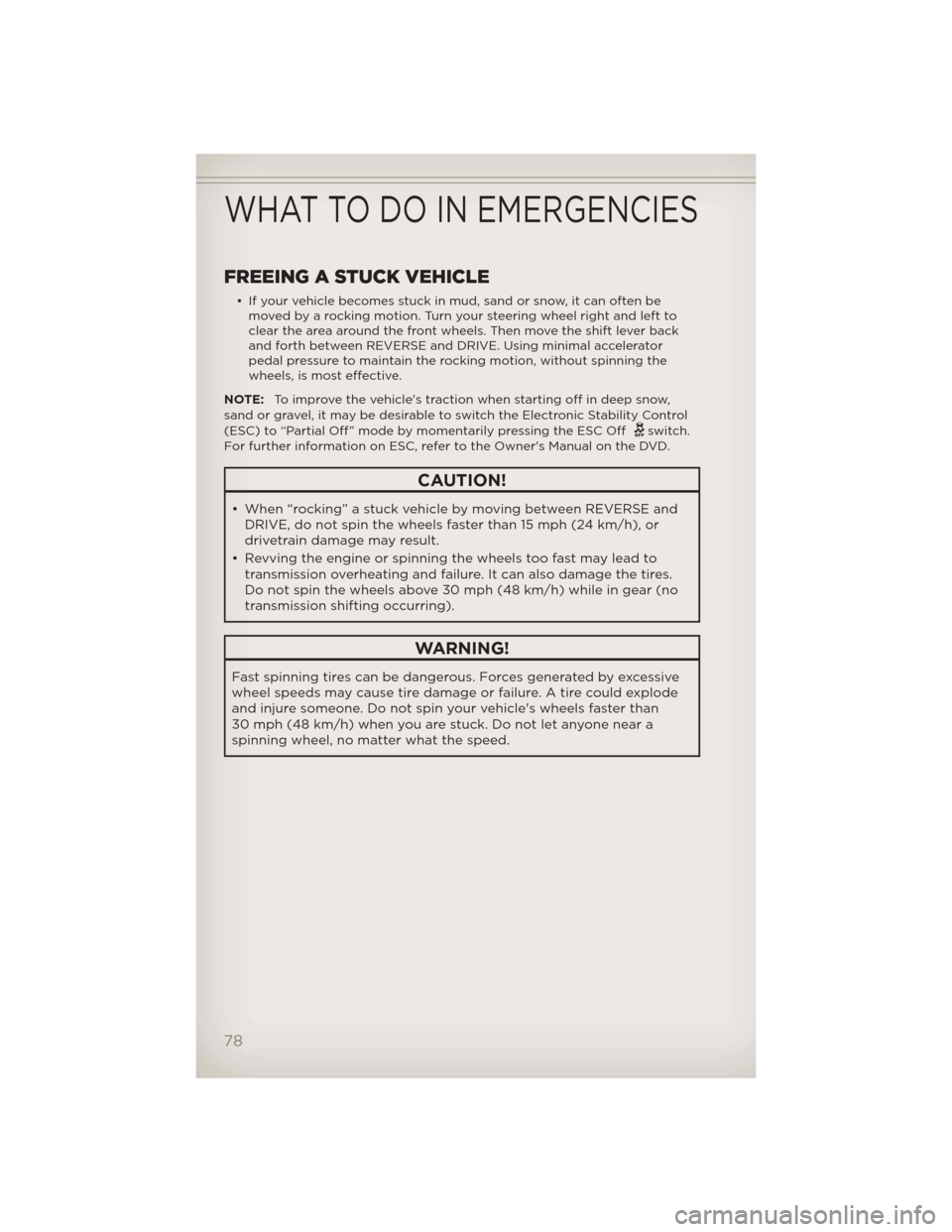
FREEING A STUCK VEHICLE
• If your vehicle becomes stuck in mud, sand or snow, it can often be
moved by a rocking motion. Turn your steering wheel right and left to
clear the area around the front wheels. Then move the shift lever back
and forth between REVERSE and DRIVE. Using minimal accelerator
pedal pressure to maintain the rocking motion, without spinning the
wheels, is most effective.
NOTE:To improve the vehicle's traction when starting off in deep snow,
sand or gravel, it may be desirable to switch the Electronic Stability Control
(ESC) to “Partial Off” mode by momentarily pressing the ESC Off
switch.
For further information on ESC, refer to the Owner's Manual on the DVD.
CAUTION!
• When “rocking” a stuck vehicle by moving between REVERSE and
DRIVE, do not spin the wheels faster than 15 mph (24 km/h), or
drivetrain damage may result.
• Revving the engine or spinning the wheels too fast may lead to
transmission overheating and failure. It can also damage the tires.
Do not spin the wheels above 30 mph (48 km/h) while in gear (no
transmission shifting occurring).
WARNING!
Fast spinning tires can be dangerous. Forces generated by excessive
wheel speeds may cause tire damage or failure. A tire could explode
and injure someone. Do not spin your vehicle's wheels faster than
30 mph (48 km/h) when you are stuck. Do not let anyone near a
spinning wheel, no matter what the speed.
WHAT TO DO IN EMERGENCIES
78
Page 86 of 108
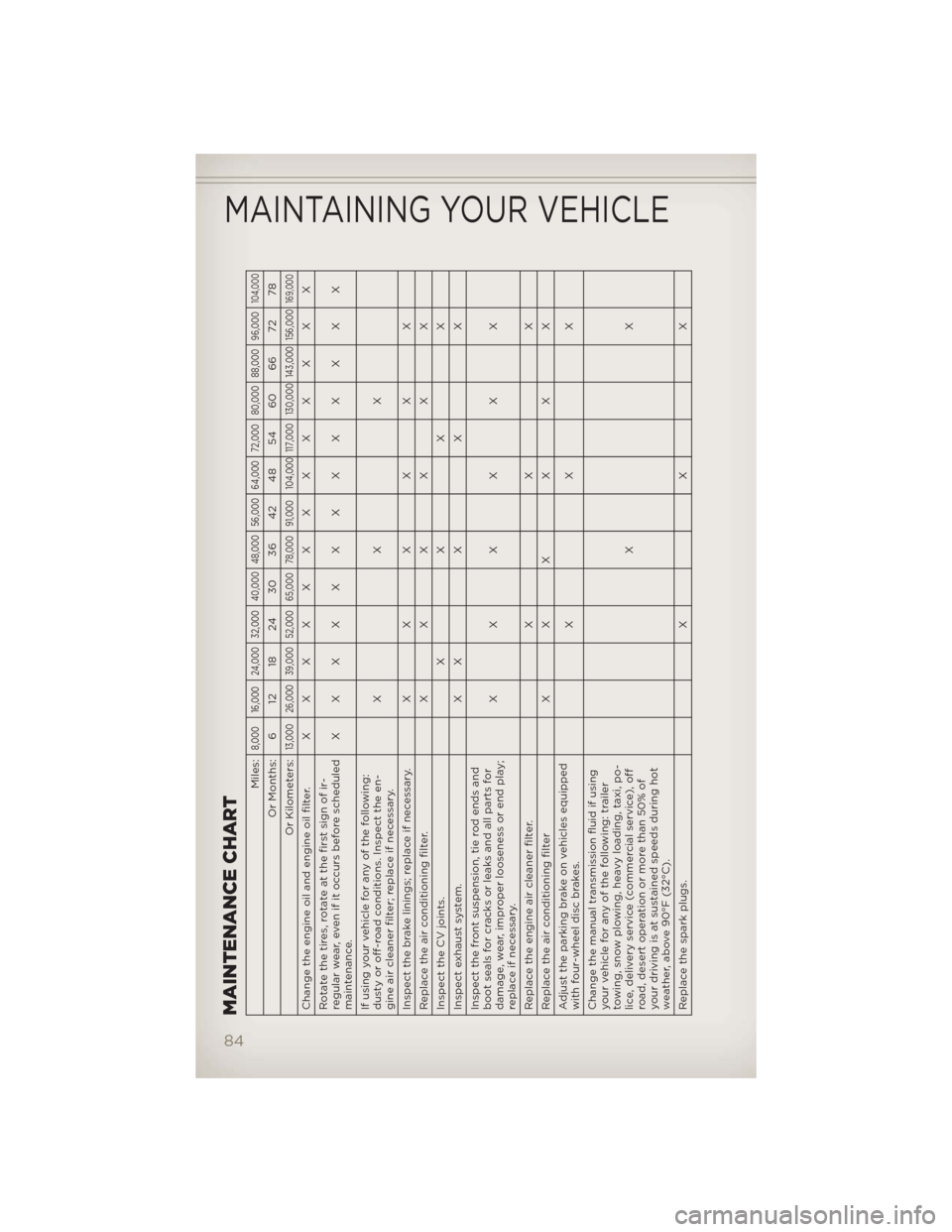
MAINTENANCE CHART
Miles:
8,000 16,000 24,000 32,000 40,000 48,000 56,000 64,000 72,000 80,000 88,000 96,000
104,000
Or Months: 6 12 18 24 30 36 42 48 54 60 66 72 78
Or Kilometers:
13,000 26,000 39,000 52,000 65,000 78,000 91,000 104,000 117,000 130,000 143,000 156,000
169,000
Change the engine oil and engine oil filter.XXXXXXXXXXXXX
Rotate the tires, rotate at the first sign of ir-
regular wear, even if it occurs before scheduled
maintenance.XXXXXXXXXXXXX
If using your vehicle for any of the following:
dusty or off-road conditions. Inspect the en-
gine air cleaner filter; replace if necessary.XXX
Inspect the brake linings; replace if necessary. X XXXXX
Replace the air conditioning filter. X XXXXX
InspecttheCVjoints. XXXX
Inspectexhaustsystem. XXXXX
Inspect the front suspension, tie rod ends and
boot seals for cracks or leaks and all parts for
damage, wear, improper looseness or end play;
replace if necessary.XXXXXX
Replace the engine air cleaner filter. X X X
Replace the air conditioning filter X X X X X X
Adjust the parking brake on vehicles equipped
with four-wheel disc brakes.XXX
Change the manual transmission fluid if using
your vehicle for any of the following: trailer
towing, snow plowing, heavy loading, taxi, po-
lice, delivery service (commercial service), off
road, desert operation or more than 50% of
your driving is at sustained speeds during hot
weather, above 90°F (32°C).XX
Replace the spark plugs. X X X
MAINTAINING YOUR VEHICLE
84
Page 91 of 108
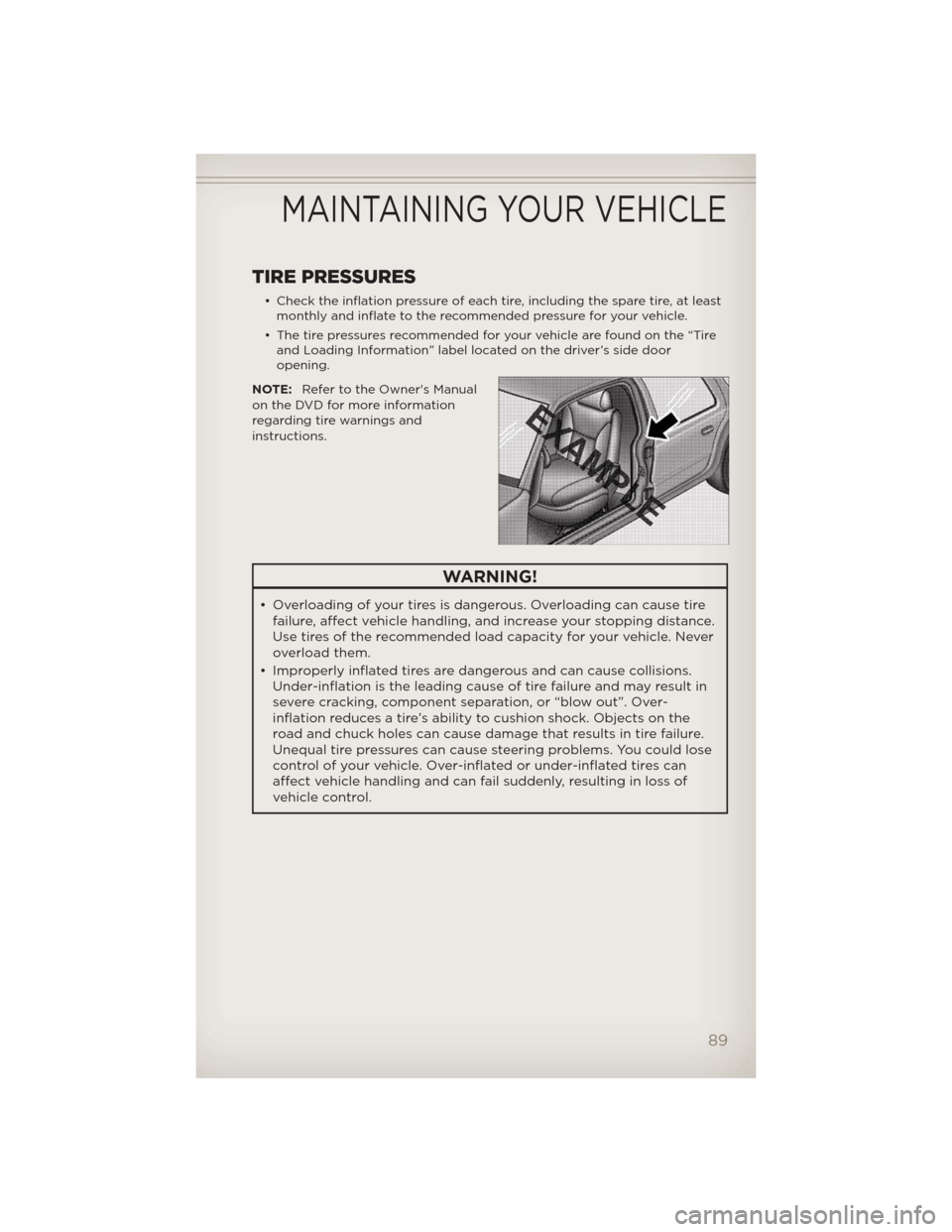
TIRE PRESSURES
• Check the inflation pressure of each tire, including the spare tire, at least
monthly and inflate to the recommended pressure for your vehicle.
• The tire pressures recommended for your vehicle are found on the “Tire
and Loading Information” label located on the driver’s side door
opening.
NOTE:Refer to the Owner's Manual
on the DVD for more information
regarding tire warnings and
instructions.
WARNING!
• Overloading of your tires is dangerous. Overloading can cause tire
failure, affect vehicle handling, and increase your stopping distance.
Use tires of the recommended load capacity for your vehicle. Never
overload them.
• Improperly inflated tires are dangerous and can cause collisions.
Under-inflation is the leading cause of tire failure and may result in
severe cracking, component separation, or “blow out”. Over-
inflation reduces a tire’s ability to cushion shock. Objects on the
road and chuck holes can cause damage that results in tire failure.
Unequal tire pressures can cause steering problems. You could lose
control of your vehicle. Over-inflated or under-inflated tires can
affect vehicle handling and can fail suddenly, resulting in loss of
vehicle control.
MAINTAINING YOUR VEHICLE
89
Page 98 of 108
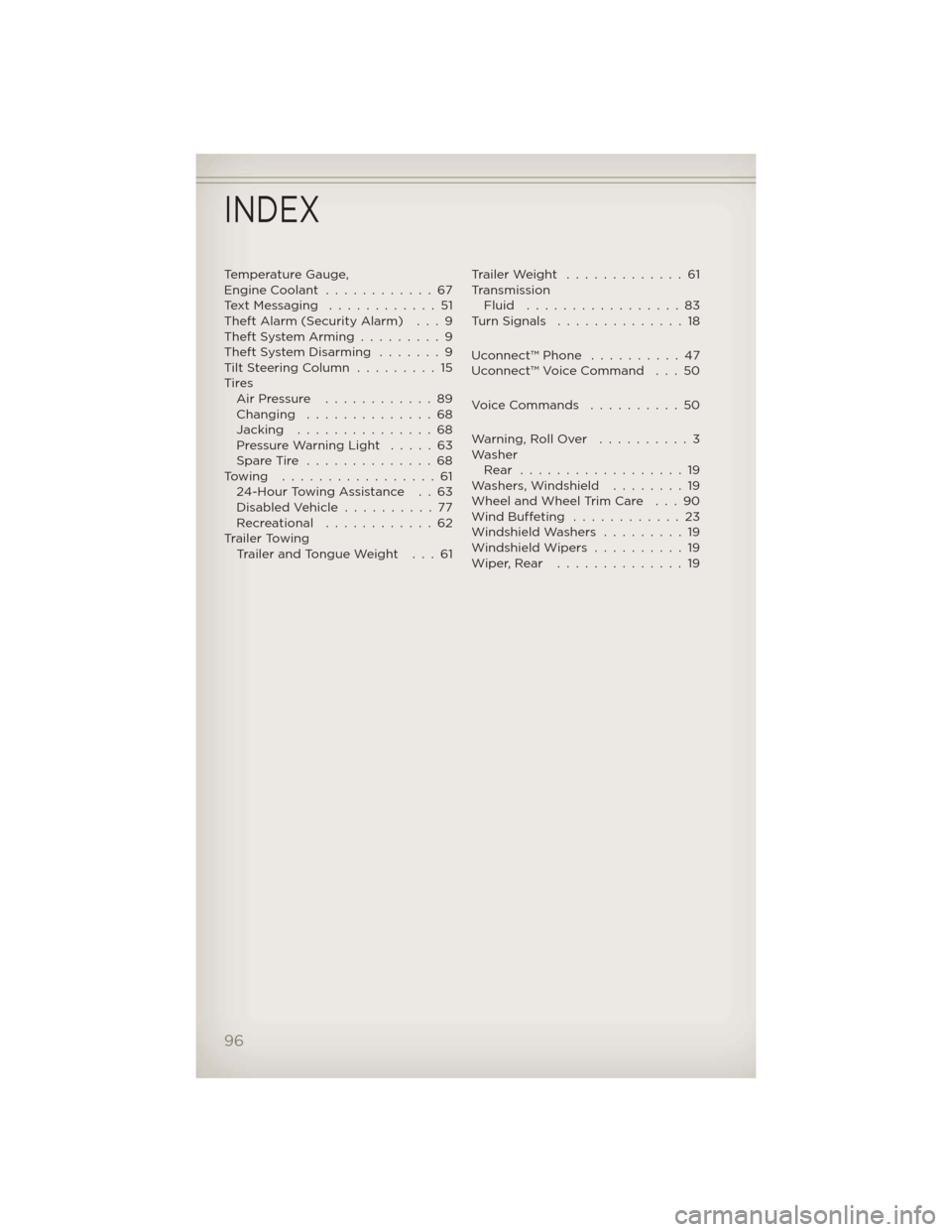
Temperature Gauge,
Engine Coolant............67
TextMessaging ............51
Theft Alarm (Security Alarm) . . . 9
TheftSystemArming.........9
TheftSystemDisarming .......9
TiltSteeringColumn .........15
Tires
AirPressure ............89
Changing..............68
Jacking...............68
Pressure Warning Light . . . . . 63
Spare Tire..............68
Towing .................61
24-Hour Towing Assistance . . 63
DisabledVehicle..........77
Recreational............62
Trailer Towing
Trailer and Tongue Weight . . . 61TrailerWeight .............61
Transmission
Fluid .................83
Turn Signals . . ............18
Uconnect™ Phone . . . . . . . . . . 47
Uconnect™ Voice Command . . . 50
Voice Commands . . . . . . . . . . 50
Warning, Roll Over . . . . . . . . . . 3
Washer
Rear ..................19
Washers, Windshield . . ......19
Wheel and Wheel Trim Care . . . 90
WindBuffeting ............23
Windshield Washers . . . . . . . . . 19
Windshield Wipers . . . . . . . . . . 19
Wiper,Rear ..............19
INDEX
96